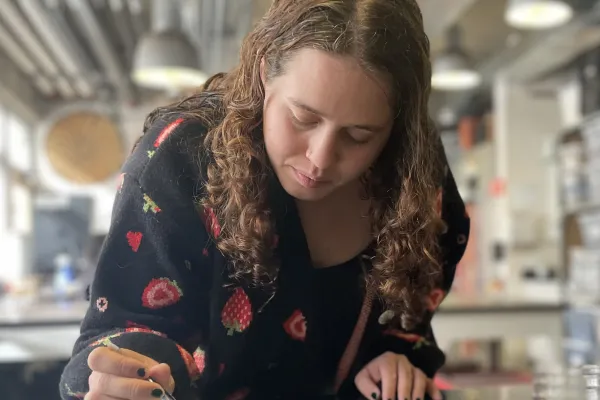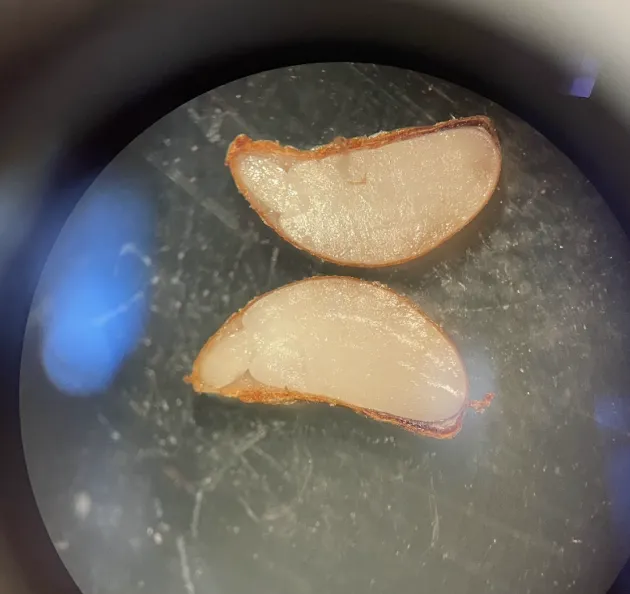Sarah McCabe '24's Lasting Impact on Botanic Garden Conservation Efforts
News

Published May 22, 2024
There are a myriad of ways students are invited to plug into the botanic garden, and one of them is as a seed physiology researcher. Over the past academic year, Sarah McCabe ’24 filled that role in the botanic garden’s seed physiology research lab under the guidance of former director Tim Johnson and then the Interim Director John Berryhill. She has worked on a few different projects during her many months in the lab–one of them for a new conservation project the botanic garden is engaged in with Massachusetts State Botanist Bob Wornerehl.
McCabe spent the year working with Bicknell’s hawthorn (Crataegus bicknellii), blue vervain (Verbena hastata), and sweetgrass (Anthoxanthum nitens) seeds, her research specifically looking at what these species need to break dormancy and germinate. While some species grow by gaining access to water and ideal temperature conditions, many seeds actually will not germinate without applying some sort of treatment. In order to break dormancy, seeds could require treatments of gibberellic acid, physical scarification, cold stratification, or other treatments prior to being planted. These treatments are intended to mimic natural processes such as passing the digestive tract of an animal or experiencing a winter, which gives the seed a cue that it is time to germinate.

While McCabe spent the year inside the lab investigating how to reliably germinate seeds, her research impacts conservation efforts that are taking place outside in the botanic garden–and beyond. The botanic garden is working to create an ex situ population of Bicknell’s hawthorn on campus as well as fortifying in situ populations in collaboration with Wornerehl, and McCabe’s research on how to germinate those seeds is integral to that process.
Bicknell’s hawthorn is unique as it is not recognized as a species federally, but it is identified as a species in New England Wild Flower Society's Flora Novae Angliae by Arthur Haines due to its unique morphological characteristics and geographic isolation. As a result, this species holds a place on the Massachusetts Endangered Species List as there are fewer than 100 left, all found on the island of Nantucket, Massachusetts. McCabe’s initial tests have revealed that many of the seeds of Bicknell’s hawthorn are not fully formed, and of the fully formed seeds less than half are viable. Despite these challenges, germination trials are underway with the hope that a population can be established in the coming years.
McCabe also spent the year working with blue vervain, a continuation of an experiment designed by the 2022-23 seed physiology researcher. McCabe reproduced the experiment to try and determine the most reliable conditions for germination. Eight hundred seeds were studied in each replication, with half being cold stratified and the other half acting as a control. The results have given insights into the ideal germination conditions for the plant, with ideas on how to improve for the future. The experimental protocol was adapted to establish a population of blue vervain at Smith College–there are currently 16 healthy seedlings being cared for at the botanic garden. This planned population in our gardens would aim to provide seed for local habitat restoration through the Northeast Seed Network.

Lastly, McCabe worked on growing sweetgrass, a culturally important plant to many Indigenous communities, with hopes of gifting it to those attending the We the Land event taking place at Smith College in August of 2024. This event is a gathering for Indigenous, Black, & Brown earth workers, land stewards & farmers hosted by Northeast Farmers of Color Land Trust. The recommended way of growing sweetgrass is through division as seeds typically have around a 10% germination rate. Luckily, after the first round of planting, many seedlings have become established. They grew within a few days despite research suggesting it could take weeks. The next round of seeds will be planted soon after their cold stratification is completed, and hopefully they will defy the odds as well as the first group. McCabe’s work marks the start of what will be an ongoing effort to grow sweetgrass from locally sourced wild seed. The goal will be to provide local Indigenous communities with reliable access to this increasingly scarce plant.
The projects McCabe started will be at the center of new conservation and restorative justice initiatives that will be front and center in our work in the decades ahead. While she moves on from Smith College as a graduating senior, McCabe leaves a lasting impact at the botanic garden through her important work in the seed physiology research lab.